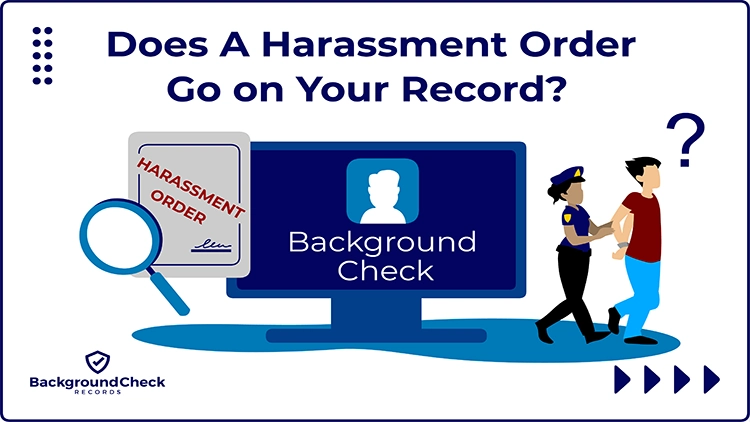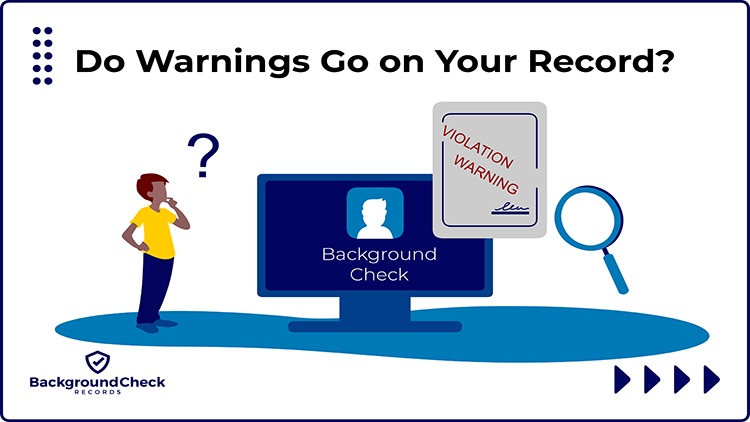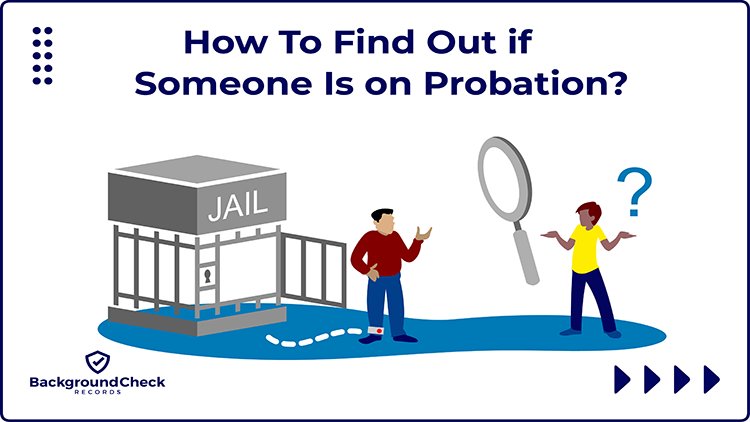Does a Harassment Order Go on Your Record: Do This To Find Out
When someone has been accused of stalking, threatening, harming, or harassing either a family member or a stranger, they may find themselves as the defendant in a harassment order, sometimes called a no-contact order or an order of protection.
This will prompt several questions about the potential impact the order could have on the person’s life, such as whether a harassment order becomes part of their record.
A harassment order can have a profound impact on a person’s ability to get a job, purchase a firearm or get licensed, so it’s vital to know if a harassment order shows up on a background check, and this free guide can give readers the knowledge and tools to do this — check court records and learn whether or not a harassment order, or another type of protective order appears on their record.
Different Types of Harassment Orders and How They Affect Someone’s Record
Not all harassment orders are built the same, and not all of them have the same impact, but each kind can have a negative effect on a person’s life. Each state sets its own guidelines about who can apply for a harassment order, what can go into one, and what kinds of behaviors are prohibited within the order.
The process is also different for each type of order; however, most act as a no contact order keeping the defendant from reaching out to the individual who requested the harassment order.1
Temporary Harassment Orders and Your Record
At times, a temporary harassment order can be entered to provide a certain level of protection until a full hearing can be conducted on the matter.
Temporary orders, sometimes called emergency orders or ex parte (meaning with one party absent from the proceeding) orders are designed to help individuals leave a situation such as domestic violence as this gives law enforcement authority to stand-by when an individual removes clothing or other items from the home, or allows law enforcement to notify the abusive partner that he or she needs to vacate the home.2
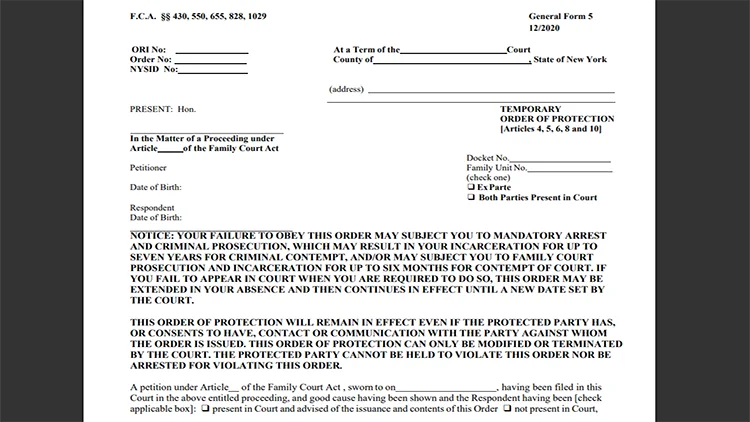
Source: The New York State Unified Court System3
Temporary orders are usually only valid for a few days, typically up to the date of the hearing. For example, a temporary order in California can last anywhere from 20 to 25 days or until the date of the next hearing, while a temporary or ex parte order in North Carolina is only valid for 10 days or until the date of the next hearing.4
When it’s a temporary order, one might wonder if a restraining order appear on a background check. Temporary harassment orders have the potential to show up on a person’s background check because they are considered public record, but usually only show up for law enforcement due to their short term.5
Permanent Harassment Orders and Your Record
Despite their name, permanent harassment orders, sometimes called an anti-harassment order, are not in effect forever.
They are called permanent orders because they are in effect for a year or more which gives the individual time to establish other, more sustainable protections such as divorce, moving to a new area, name and social security number changes or other safety plans.
For example, a permanent order in New York can be in effect for up to 5 years, whereas a permanent order in Texas is in effect for up to 2 years. Other states have similar guidelines, with some requiring a review after 1 to 2 years before extending a harassment order for an additional year or years.
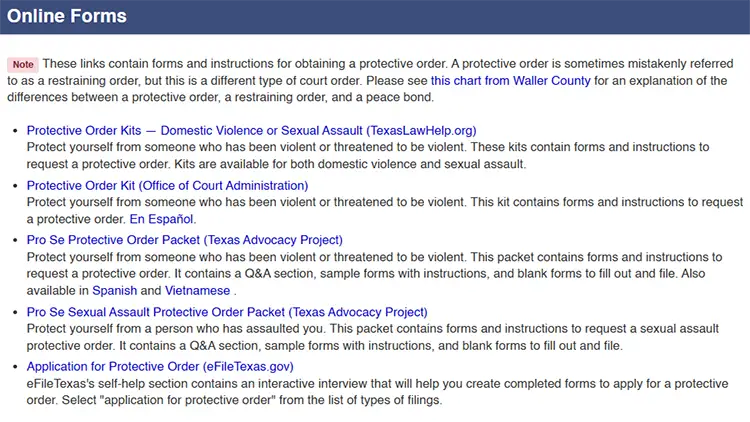
Source: The Texas State Law Library6
One might inquire whether a harassment order becomes part of your record when it’s permanent. Permanent orders are also considered public record and can have a greater impact on a person’s life than a temporary order, and do go on a person’s record.7
Domestic Violence Protective Orders and the Impact They Have On Your Record
A very specific type of harassment order is a domestic violence protective order or order of protection. An intimate relationship such as dating partners, married couple, parent/child or other family relationship must be established for a domestic violence order.
These can be temporary or permanent and can have a huge impact on a person’s life.8
One might wonder if a harassment order is recorded when it pertains to domestic violence. Yes, these orders are considered the most damaging of the various types of restraining orders since they can carry the most penalties and impact a person’s life in multiple ways.
Domestic violence orders are public record and are used for a number of different background checks, the effects of which will be discussed later in this article. Each state has its own guidelines for the issuance of a domestic violence order of protection.
In addition to protective orders, domestic violence incidents can also carry criminal charges, both misdemeanor or felony offenses. When a person is charged with a criminal domestic violence offense, bond conditions also act as a no-contact order since conditions of bond require the person to stay away from the victim until the matter is resolved in court.
This means a person’s record can reflect both the protective order in civil court and the pending charges in criminal court for the same incident.
Harassment Orders vs Restraining Orders: Are They Different?
Many people use the terms harassment order and restraining order interchangeably, but some may wonder if they are actually the same thing.
A harassment order is simply a form of a restraining order that orders the defendant to cease all harassing activities including contacting the individual in person, electronically, or through a third party. A harassment order, like other restraining orders, can also order the person to stay away from an individual.
Does Harassment Stay On Your Record? How Long Does a Harassment Charge Stay On Your Record?
Both temporary and permanent harassment orders can appear on a person’s record, but here are some differences in how they show up based on the types of order and what happens in the courtroom when the case is reviewed.
Temporary Harassment Orders
Temporary harassment orders are public records that can stay on file and accessible to the public forever.
Anyone can go to the courthouse and look up the record at a public terminal maintained by the clerk of court’s office if they wanted to do their own deep-dive into a person’s history for personal uses, but there may be limits on how long they can be accessed by those doing employment screenings.

Source: The Official Web Site for Virginia’s Judicial System9
Temporary orders are mainly used by law enforcement to alert if an order has been entered and possibly needs to be served on the defendant or when law enforcement responds to a domestic incident.
If the temporary order isn’t continued by a judge or converted to a permanent order at hearing, it does not show up as an active order after it expires or the hearing date occurs.10
Permanent Harassment Orders
Permanent harassment or restraining orders also stay on a person’s record indefinitely, even after they have expired or when a case has been dismissed by a judge without issuing a permanent order. Harassment orders are civil actions, but can appear on criminal background checks, and violations of orders are handled as criminal matters that can appear on a person’s criminal history report.11
Other factors that can impact how long a harassment order may appear on a person’s background check are the lookback periods in the state where the screening is being completed. For example, states with a seven year lookback period will limit how long a record of a harassment order can be disclosed.
When an order is in place, it can impact a person’s entire life in a number of ways. The effects can be both short and long-term, so it’s vital to understand the negative impact of being subject to a harassment order.
How To Know If You Are Subject to a Harassment Order
There are two main ways to know if you are subject to a harassment order. The first is you have received a summons to court saying someone is seeking an order of protection against you.
This is the most common way people find out they are subject to a harassment order since service, meaning law enforcement has placed the order in the person’s hand informing them they have been placed under court sanctions or until a person receives notice of delivery through certified mail that they are under a protective order, must be successful before the courts can hear a case, they are present for the case, and the judge issues the order immediately following the hearing.
Servicing someone with the court’s order is also how someone learns there is a temporary order against them since this is included in the paperwork received when the person is served with notice to appear in court. Also, since some temporary restraining orders require a person to vacate a home or property, law enforcement must advise them of the order at time of service and remove them from the premises.
Another way a person can find out they are subject to harassment order is to go to the clerk of court’s office in their area and use the public terminals or inquire at the clerk of court’s office to check restraining order status. If there is an order, the individual can obtain a copy of it at that time as well.
A person can also hire an attorney to inquire about the existence of any orders of protection against them. If there are criminal charges in conjunction with the harassment order, the attorney can strike a bargain with the court to enter the civil order, and this can be a way to have charges dismissed before court date in criminal court.
How To Check If a Harassment Harassment, Restraining or Protective Order Is on Your Record
If a harassment order, restraining order, or protective order is on your record, this can be found by looking through public court records. Oftentimes these records will be held at the local courthouse but some states have a unified court system as well.
To see if a harassment order is on your record, type “[County Name] County criminal records” or “[County Name] County court records” into your preferred search engine. For example, “Dallas County Texas court records.” If you live in a large city or a state that has a unified court system, you may also try to input the name of your city or state instead.
Check all the top .gov websites and run your name through their online search tools. Additionally, your county clerk of court can assist in retrieving records and third party sites can assist in checking several counties or jurisdictions at once.
How a Restraining Order Can Affect Your Life: Background Screenings and Orders of Protection
When a person becomes the subject of a harassment order or restraining order, it can impact almost every aspect of that person’s life. The extent of the impact is based on the type of order entered, how long it is in effect, and the restrictions a judge places on the defendant within the order.
Harassment orders can show up on background checks for housing or employment, and other screenings that a person may undergo.
Law enforcement also logs, or records, services of restraining or harassment orders and has to fill out a police report. Some may wonder if police reports are visible on background checks. No, they typically do not, but they are still considered public record and if someone is seeking that particular information it is discoverable.
Level 1 Background Checks
Level 1 background checks are typically name-based screenings for things such as employment checks or personal use. A harassment order can appear on a level 1 screening, but it is not as likely as other, more in-depth background checks.
Depending on what the screening is for, a harassment order can prevent a person from getting a position with a company, and it may impact the individual’s personal life.
Level 2 Background Checks
A level 2 background check includes more data than a level 1, and a harassment order is more likely to show up on this type of screening. Because these are finger-print based screenings, they are also more likely to reveal out-of-state harassment orders if the defendant has moved.
This can also impact a person’s ability to get gainful employment, and could jeopardize housing applications.
Level 3 Background Checks
A level 3 background check goes into even more detail than a level 2 and can include interviews with individuals who are familiar with the subject and the order can be revealed during character interviews. This can impact licensure, employment and housing opportunities negatively.
Level 4 Background Checks
In a level 4 background check, a harassment order is likely to be discovered and can have a negative impact on the person’s ability to get the position that necessitated the level 4 screening.
Firearms Checks and Harassment Orders: What Everyone Needs To Know
An order of protection for domestic violence can prevent a person from legally purchasing a firearm in the United States. Title 18 USC 922(g)(8),924(a)(2) prohibits anyone subject to an active domestic violence order of protection from purchasing or possessing any firearms or ammunition, and violation of this statute could result in a person being placed in prison for up to 10 years.12
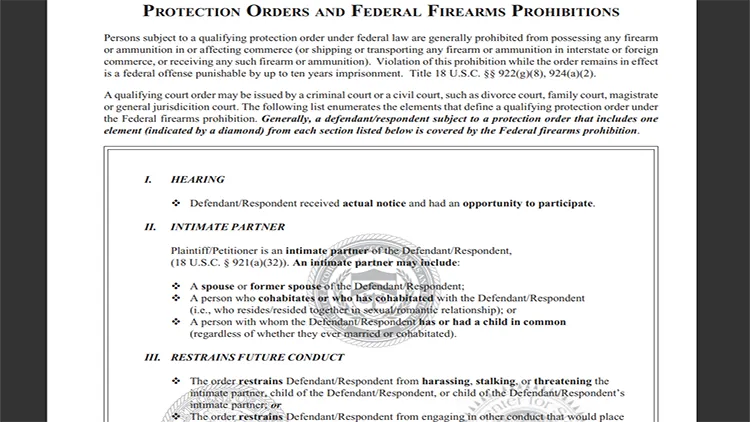
Source: The ATF13
States can pass their own laws including general harassment orders which would prohibit the person from possession of a firearm in that state, or transporting a firearm from another state to the state with the prohibition. For example, California prohibits purchase or possession of a firearm if under a civil harassment order or an domestic violence order.
Per the federal Brady Bill, when a person purchases a firearm through an FFL (Federal Firearms Licensee), a screening is done through the National Instant Criminal Background Check System (NICS) maintained and administered through the FBI. This check will flag a person who is subject to an order of protection showing they are ineligible to purchase a gun.
Further, a person subject to a harassment order may be ordered to surrender any firearms they have to the local sheriff’s office to be stored (at the defendant’s expense) until the matter is resolved by the court does not enter an order providing relief or the order expires after being entered.
Protective Orders: How Employment Can Be Affected
Individuals in positions that require working with vulnerable populations such as children, disabled individuals or elderly people may also be removed from their jobs due to a protective order. In addition, gaining licensure in any position of this nature can be impacted negatively including revoking licensing, imposing fines or fees, or denying a professional license.
A protective order or harassment order can have a profound effect on a person’s employment. For example, under the Lautenberg Amendment, when someone has a protective order or harassment order entered against them due to domestic violence, they cannot possess, transport, purchase or carry a firearm which means law enforcement officers, active duty military members, correctional officers or other armed professions can be fired from their jobs due to order.14
Individuals with security clearance can also find they have been stripped of their clearance due to the issuance of a protective order against them since these places them in a higher risk category for breaching security measures.
A protective order can be the basis for denying someone a position during the screening process; however, using the order must be weighed the same as using criminal convictions, meaning if the order does not have a direct impact on a person’s position, they may still be hired if the company wishes to do so. A harassment order can lead to a failed background check after job offer negotiations have started resulting in the job offer being taken back, but does not have to be the final word in all cases.
The Impact of a Harassment Order on Housing
The biggest impact a harassment order can have on housing is the removal of the accused from the home they share with the person seeking the order. When a judge orders one party to vacate the premises, this can place a huge burden on the accused.
Additionally, the order can state they cannot be within a certain distance from the individual, meaning they cannot seek housing close to the person’s home.15
In matters of family law, this can mean individuals co-parenting may live a large distance apart due to the harassment order making visitations and other issues regarding the children more difficult to navigate.
Other Impacts of a Harassment Order on a Person’s Life
Some of the other impacts a harassment order can have is on the individual’s personal life. Harassment orders can be used in child custody cases to show that one parent is a danger to the children.
Individuals may lose love interests when the other person finds the individual is subject to a harassment order or has been in the past when doing marriage background checks.
A judge can also place restrictions in orders such as mandatory attendance in abusers’ treatment, substance abuse treatment or other forms of therapy. Violating harassment orders can result in a criminal record. Therefore, it’s crucial to recognize that a harassment order does indeed go on your record and can significantly affect various aspects of your life.
One might inquire whether background checks display out-of-state harassment or protective orders, or if a harassment order is recorded in every state.
Yes, it can and the impacts can follow a person if they move from one state to another. When a nationwide search is conducted, it can show out-of-state harassment orders or orders of protection in addition to any actions taken within the state, including violations of the order.
Also, due to the Full Faith and Credit Clause in the US Constitution, orders issued in one state are valid throughout the entire country including US territories.

Source: The Constitution Annotated16
Harassment orders may also impact a person’s ability to volunteer at their child’s school or with a community organization if it appears on non-profit background checks. Nonprofits screen volunteers to make sure they are a good fit and are not a danger to the population served, and a harassment order is a red flag to the nonprofit organization.
Protective Order Process: How Does a Harassment Order Work?
Knowing how the harassment order process works can help individuals prepare for the possible impact one can have on a person’s prospects. A general outline of the steps to seek a protective order is below:
- An individual has been subjected to abuse, harassment, stalking or otherwise threatening behavior either by someone they are in a relationship with or a stranger or other acquaintance.
- The person placing the order goes to the local courthouse clerk of court’s office to file a petition for a protective order. In this stage, an attorney can be a valuable resource as the attorney’s office will fully understand the laws regarding protective orders and can draft the petition.
- The individual has the option to request an emergency order when filing.
- When an emergency order is requested, the judge or magistrate will review the petition and may or may not question the person filing. A decision is made at that time whether or not to grant an emergency or temporary order.
- A court date for a hearing on a permanent order is set at the time of filing. When an emergency order is granted, the hearing must be scheduled as quickly as possible, typically within 10 days but in some states can be as much as 25. Most cases are set for the following week.
- A hearing is held in which both parties can present evidence and testimony. This hearing is presided over by a judge or magistrate.
- The court official makes the final decision about a permanent protective order. When an order is entered, the person is advised in court of the consequences of violating the order.
- The clerk files the documentation of the hearing in the case record, which is accessible to the public, addressing whether a harassment order becomes part of your record.
- Approximately 90 days from the expiration date of the order, if the person who filed the harassment order feels they still need the protection provided by it, they can file a motion to renew the order.
Violations of protective orders can be handled in either civil or criminal court. For example, the offense of violating harassment order in Massachusetts is considered a criminal offense.
Some protective orders, such as domestic violence orders, allow for law enforcement to arrest a violator.
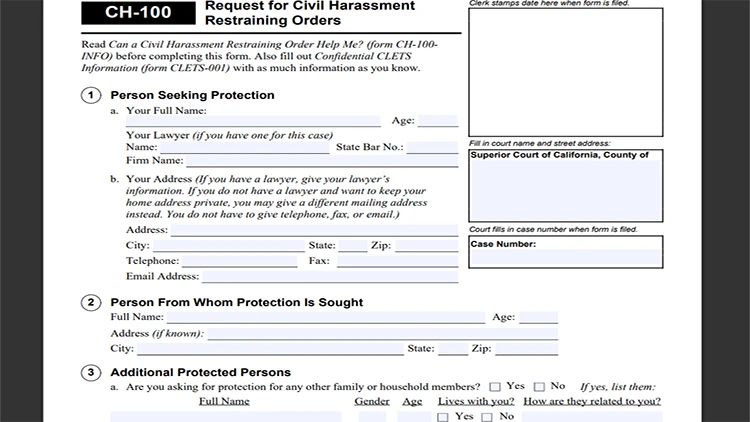
Source: The California Courts17
Other orders such as generic restraining orders may require a person file a motion to show cause in civil court. This simply means the matter is brought before a civil court judge to see if the person did violate the order and should be found in contempt of court.
Contempt of court is considered a criminal offense which goes on a person’s record as well.
Requirements for Obtaining a Harassment Order
Each state has its own laws regarding obtaining a harassment order, but the criteria is mostly universal when it comes to the elements that must be met. Some of the requirements for a harassment order are listed below:
- There must have been a qualifying event or series of events such as documented stalking, repeated harassing phone calls, domestic violence, sexual abuse/assault, or other harassment or threatening behavior.
- In some states, there must be some type of intimate relationship such as marriage, dating, cohabitation (living together), parent/child or other family relationship. Some states have separate orders for intimate partner violence and stranger or acquaintance violence.
- A petition must be filed with the court as outlined above.
- Since this is a civil action, the plaintiff (also known as the victim or person who filed the harassment order) must only prove by a preponderance of the evidence that the events occurred and the order for protection is necessary to stop future harassment. A preponderance of the evidence simply means there is enough evidence to show the events occurred and the defendant is likely the person who did it. Civil court does not have as high a burden of proof as criminal court.
- If the courts require a filing fee, this must also be paid at the time of filing; however, many states waive court fees for protective orders.
The terminology for the order may be different from state to state as well. For example, a restraining order in Maryland is referred to as a peace order.
North Carolina has both a domestic violence protective order and a civil no-contact order that individuals can seek.
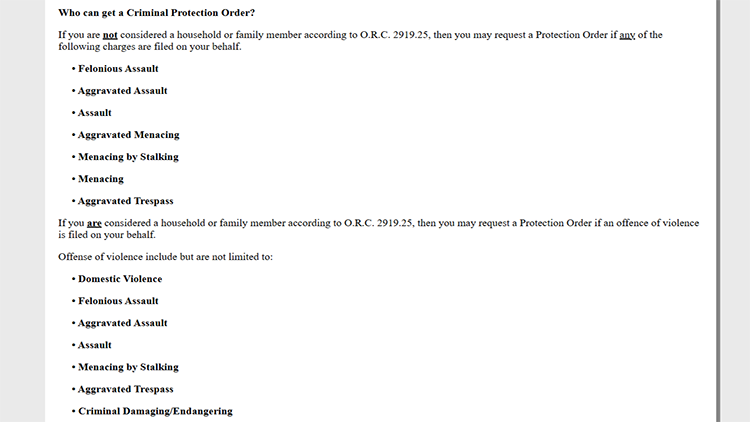
Source: The Columbus City Attorney’s Office18
When the matter is before the judge or magistrate, the plaintiff (person who filed the harassment order) has the burden to prove the defendant did the actions listed in the complaint by presenting evidence and testimony. The defendant has the right to question any witnesses or the filer regarding the statements in the petition or those made on the witness stand.
The defendant can also present any evidence they have available. The judge then makes a ruling on whether or not to grant an order or dismiss/drop the action.
Impact of Dismissed or Dropped Restraining Orders
When the order is dismissed, the defendant will want to know what kind of impact it will have from that point, if any. Unfortunately, a dismissed or dropped restraining order will still appear on a person’s record.
One might wonder how a harassment order appears on your record after it has been dismissed. The record will show if the matter was dismissed by the plaintiff or if the court denied the order and dropped the action.
A dropped or should not continue to have negative impacts on a person’s life since they are no longer under a court’s order.
For example, in a level 1 background check, a dropped or dismissed restraining order is not likely to show up. A security clearance screening, however, may reveal that the person was accused of an incident that met the criteria for seeking a restraining order.
In cases where the screening is going to be much deeper than a surface background check, it is important to disclose the matter in the beginning as a dropped or dismissed restraining order rather than try to do damage control if it is discovered by the person doing the background check.
Another impact that a dropped or dismissed restraining order has been the cancellation of a temporary or emergency order of protection. Since the permanent order is denied or the matter dropped or dismissed, the temporary order simply expires and cannot be used against someone and is no longer enforceable by law.19
Expired Harassment Orders and Their Impact
As with dropped or dismissed harassment orders, an expired order is no longer enforceable and cannot be used as a determining factor in hiring or housing decisions unless otherwise written into law. Any violations of the order can still have an impact if the person was convicted of the violations since these are criminal offenses.
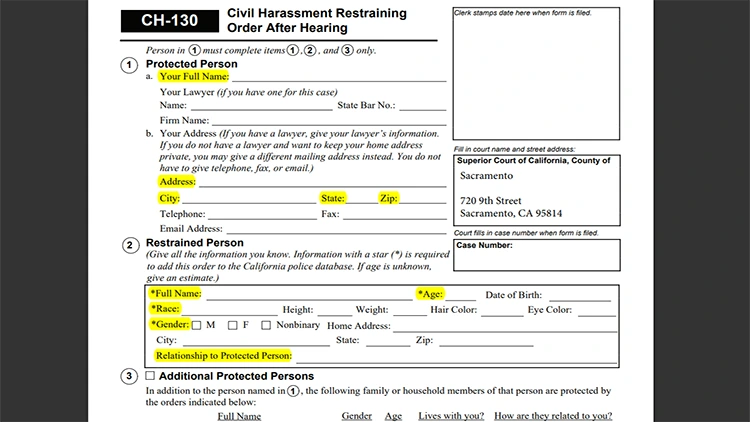
Source: The Sacramento Superior Court20
An expired order does not necessarily mean the person is free to resume the activities that caused someone to petition the courts initially such as contacting the person who filled the harassment order. In fact, the individual should not reach out to the other party once the order expires because this can put them at risk of a new civil harassment restraining order.
If there have been no misdemeanor domestic violence charges or other disqualifiers in addition to the restraining order, the individual is also free to petition the court for the retrieval of any firearms seized by law enforcement, or the purchase and possession of new firearms in many states. Individuals should check with an attorney regarding firearms after a restraining order has expired to make sure they are in compliance with state and federal laws.21
Being subject to a harassment order can significantly impact various aspects of a person’s life. It’s crucial to understand that these orders can be discovered when questioning whether a harassment order becomes part of your record.
Frequently Asked Questions
How Long Are Temporary Orders Active?
Temporary orders can remain in effect until a permanent order is in place or the action is dismissed, dropped or denied in court. Most initial temporary orders are good for 10 to 25 days, but can be continued at the first hearing if there is no service or the matter is continued to a later date.
Can Harassment Orders Be Expunged?
Since a harassment order is a civil action it is not subject to expungement like a criminal offense. Civil actions, by virtue of not carrying the threat of incarceration at the onset, are considered less damaging to a person’s record, so the statutes do include an expungement process for these matters. Additionally, violations of harassment orders that are criminal offenses are often excluded from expungement consideration by state laws.
Does an Injunction Against Harassment Go On Your Record?
Yes, an injunction against harassment does go on your record and can show up on a criminal background check.
Does a Harassment Order Remain on Your Record After It’s Expunged?
As stated earlier, there is no expungement process for harassment orders; therefore, even if they are dismissed, dropped or denied, they will still appear on a person’s record.
1 What is the Difference Between a Harassment Restraining Order and a Domestic Violence Restraining Order? (2022, August 15). Vanden Heuvel & Dineen S.C. Retrieved March 5, 2023, from <https://vhdlaw.com/difference-in-restraining-orders/>
2 Guillen, L. (n.d.). Temporary Restraining Orders. DivorceNet. Retrieved March 5, 2023, from <https://www.divorcenet.com/resources/divorce/temporary-restraining-orders.htm>
3 System, N. Y. S. U. C. (n.d.). Forms – N.Y. State Courts. Copyright © 1996-2022 Office of Court Administration, the New York State Unified Court System – ALL RIGHTS RESERVED. Without Prior Written Consent, Any Form of Copying or Alteration Is Strictly Prohibited. <https://www.nycourts.gov/LegacyPDFS/FORMS/familycourt/>
4 The Three Main Types of Restraining Orders in California | Orange County Crime Defense Lawyers. (n.d.). Johnson Criminal Law Group. Retrieved March 5, 2023, from <https://www.californiacriminaldefender.com/the-three-main-types-of-restraining-orders-in-california.html>
5 Are Restraining Orders Public Record. (n.d.). Law Office of Christopher Chaney. Retrieved March 5, 2023, from <https://www.ceclaw.net/are-restraining-orders-public-record/>
6 “Protective Orders – Commonly Requested Legal Forms – Guides at Texas State Law Library.” Texas State Law Library. Accessed 29 April 2023. <https://guides.sll.texas.gov/legal-forms/protective-orders>
7 A Plaintiff’s Guide to Restraining Orders – School of Law. (n.d.). University of South Carolina. Retrieved March 5, 2023, from <https://sc.edu/study/colleges_schools/law/academics/experiential_learning/clinics/domestic_violence/_resources/ro_plaintiff.php>
8 What Are the Consequences of an Order of Protection? (n.d.). HG.org. Retrieved March 5, 2023, from <https://www.hg.org/legal-articles/what-are-the-consequences-of-an-order-of-protection-49151>
9 The Official Web Site for Virginia’s Judicial System. Accessed 29 April 2023. <https://www.vacourts.gov/forms/district/dc383inst.pdf>
10 How Restraining Orders Impact Your Life, Record. (2019, March 13). Husker Law. Retrieved March 5, 2023, from <https://www.huskerlaw.com/blog/2019/03/how-restraining-orders-impact-your-life-record/>
11 Pirius, R. (n.d.). What Is a Restraining Order Violation? CriminalDefenseLawyer.com. Retrieved March 5, 2023, from <https://www.criminaldefenselawyer.com/crime-penalties/federal/Violation-of-Restraining-Order.htm>
12 PROTECTION ORDERS AND FEDERAL FIREARMS PROHIBITIONS. (n.d.). ATF. Retrieved March 5, 2023, from <https://www.atf.gov/resource-center/docs/guide/protection-orders-and-federal-firearms-prohibitions-atf-i-33102/download>
13 “PROTECTION ORDERS AND FEDERAL FIREARMS PROHIBITIONS.” ATF. Accessed 29 April 2023. <https://www.atf.gov/resource-center/docs/guide/protection-orders-and-federal-firearms-prohibitions-atf-i-33102/download>
14 Barthel, G. S. (n.d.). A legal practitioner’s guide to the Lautenberg Amendment. Military Law Center. Retrieved March 5, 2023, from <https://militarylawcenter.com/weapons-hold/>
15 Colorado Springs Attorney Explains Civil Protection Order Consequences. (n.d.). Law Offices of Clifton Black. Retrieved March 5, 2023, from <https://www.cliftonblacklaw.com/practice-areas/criminal-defense/domestic-violence/protective-orders/civil-protection-order-consequences/>
16 “Overview of Full Faith and Credit Clause | Constitution Annotated | Congress.gov | Library of Congress.” Constitution Annotated. Accessed 29 April 2023. <https://constitution.congress.gov/browse/essay/artIV-S1-1/ALDE_00013015/>
17 California Courts – Home. Accessed 29 April 2023. <https://www.courts.ca.gov/documents/ch100.pdf>
18 “Guide to Protection Orders.” Columbus City Attorney’s Office. Accessed 29 April 2023. <https://city-attorney.columbus.gov/prosecution-guidetoprotection.aspx>
19 What Happens to Temporary Orders When a Case is Dismissed? (2017, October 20). UNC School of Government. Retrieved March 5, 2023, from <https://www.sog.unc.edu/blogs/civil-side/what-happens-temporary-orders-when-case-dismissed>
20 “Civil Harassment Restraining Order (CHRO) Step 1 Packet.” Sacramento Superior Court. Accessed 29 April 2023. <https://www.saccourt.ca.gov/restraining-orders/docs/cv-ch-01.pdf>
21 What will happen to the abuser’s gun when my DVPO expires? (2022, February 14). WomensLaw.org. Retrieved March 5, 2023, from <https://www.womenslaw.org/laws/nc/state-gun-laws/guns-and-dvpos/what-will-happen-abusers-gun-when-my-dvpo-expires>

